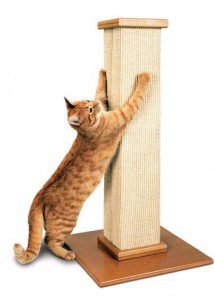You can try putting aluminum foil, double sides tape and even sticky paws on objects to help them stay away. Sometimes even using fragrances like citrus.2: Get good scratching surfaces:
“For every no, provide a yes” Place the yes surfaces next to the no surfaces to help retrain them. Cardboard scratching post are a good choice.

3: Provide distraction to prevent scratching:
Get a toy that they really like and play with them to distract them. Always make sure to distract them prior to them scratching otherwise they will think it’s a reinforcement to good behavior which could make them scratch more.
4: Trim Nails:
Make sure to use cat trimmers because they are smaller and make the process a lot easier. Don’t rush it, we get that some cats really don’t like this so don’t think you have to get all the toes done at once. A trick I learned was to try to get some don’t when they are sleeping or really relaxed you can usually get a few done at that point if not all of them.
5: Vinyl nail caps:
An example are the “Soft paws” brand. They are gel caps that last for about 4-6 weeks and will fall off on their own. Then you can reapply as needed.
6: Pheromone Sprays:
A good example is the brand “Feliway” you can plug this in to use in certain rooms or they even have wipes and sprays that you can use directly on the objects. The spray has “happy” pheromones in it that can help because cats are very territorial and have scent glands in their paws which is the main reason why they scratch.

When choosing a scratching post make sure to look at a few key factors. Check the height. Make sure it’s tall enough so that you cat can fully stretch and extend when using it. Make sure they are stable so that it doesn’t wobble and have the potential to fall over. Also look at the fabric that’s on it. A good kind is sisal fabric. Also look at the location. Make sure it’s in a prominent area because they scratch to mark their territory.
